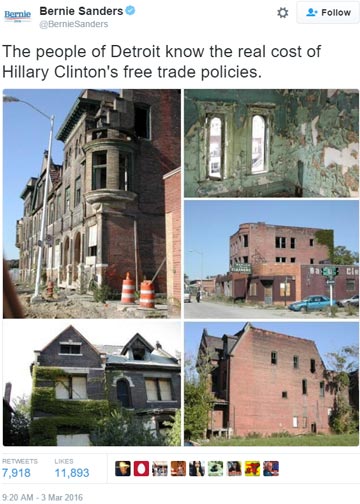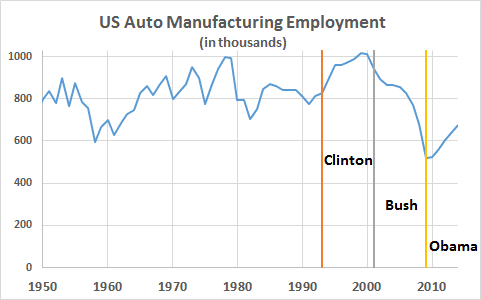 To win Michigan, Bernie sent out the tweet shown below. It implies that Clinton caused the ruination of Detroit, supposedly by backing NAFTA.
To win Michigan, Bernie sent out the tweet shown below. It implies that Clinton caused the ruination of Detroit, supposedly by backing NAFTA.
Besides Toyotas (not under NAFTA), Bernie also “forgot” automation, white flight from Detroit, the rise of manufacturing in the South, and Bush’s great Recession. That’s a lot to forget when accusing the likely Democratic candidate for president of destroying a major American city along with its working class. None of this had anything to do with Hillary.
And NAFTA? The strange thing is, for autos, it mainly removed a tiny 3% tariff on auto imports from Mexico. How could that cause much of anything? Puzzled, I read the AFL-CIO NAFTA webpage which had an alarming graph of Mexican imports by Mr. McMillion, so I Googled him: “In fact,” he said, “the U.S. trade surplus with Mexico vanished within months of NAFTA’s implementation and worsened rapidly…”
Sure enough, it did. But the shift was just way too sudden to be explained by building factories in Mexico. So I Googled some more and found the “Mexican peso crisis,” aka the “Tequila crisis.” Their 1994 presidential election (and revolt in Chiapas) caused Salinas to overspend and peg the Peso too high. This came to a bad end in December 1994, when the Peso was allowed to “float.” Actually it sank. To half its previous value and stayed there.
From the US point of view, everything was on sale for half off. That’s why imports from Mexico suddenly jumped, and that’s what mainly boosted investment in Mexico — not the puny 3% tariff reduction caused by NAFTA.
Yes, trade policy hurt American workers—by allowing Americans to buy VWs and Toyotas from Germany and Japan. But that had nothing to do NAFTA and even less to do with Clinton. Bernie just doesn’t seem to know what he’s talking about. Here’s the full story.
The Collapse Started Long Before NAFTA

Bernie’s Completely Misleading Tweet. Why did he do it?
Detroit’s population has been dropping since 1950. The worst decade was caused by OPEC’s price hikes and saw a population drop of 311,000, as people switched from gas guzzlers to Toyotas. The best decade, 1990 – 2000, saw a drop of only 76,000. That was Bill Clinton’s decade.
Michael Moore’s famous documentary, Roger & Me, showed abandoned buildings in Michigan that look just like Bernie’s tweet. That was shot in 1988, six years before NAFTA and five years before Bill Clinton took office. Bernie remembers that movie. He saw OPEC and the surge of Toyotas and all the rest, except perhaps what NAFTA actually did.
NAFTA
Obviously, when you make it cheaper to import auto parts from Mexico by reducing the US tariff on imports, auto manufacturers will be more likely to take advantage of the cheap labor and build plants in Mexico. But why doesn’t Bernie ever mention that tariff — the barrier that NAFTA obliterated?
Perhaps it’s because before NAFTA the tariff on autos was only 2.5% and on auto parts from Mexico only 3.1%. Some US auto parts already were being made in Mexico. But that extra 3% savings, when wages were already more than four times cheaper in Mexico, was not going to change things all that much. But then in December 1994, when the value of the Peso dropped and everything Mexican went on a permanent half-price sale, that changed everything. Then some auto-parts plants did relocate to Mexico.
There’s a story out there that NAFTA was obviously going to be a disaster for workers, and Hillary, being brilliant, obviously knew this. So she must have done it on purpose. But again, there’s a little fact Bernie doesn’t mention. NAFTA also eliminated barriers that kept US companies from selling US cars into Mexico. Officially the tariffs against the US auto industry were only 10 to 20 percent. But that’s not the half of it.

This and the pictures below are from Roger & Me, and were taken six years before NAFTA in Flint Michigan
Mexico had so many other restrictions, that compact US cars were selling for $30,000 in Mexico way back then. That’s like a 200% tariff — a lot more than 3% — against US cars. And economists thought that if NAFTA got rid of those 200% barriers (which it did), Detroit might sell more cars, and this might compensate for removing that 3% protective barrier. And Hillary, being a policy wonk, surely read the research, and it seemed reasonable.
Now perhaps the research was wrong. But given the fact that Detroit and Flint were collapsing decades before NAFTA, and given the smallness of three percent and the hugeness of 200%, and given that the increase in Mexican imports can easily be explained by Mexico’s half-price sale caused by the Tequila crisis, I wouldn’t jump to conclusions. And the graph below shows no ill effect during Clinton’s Presidency.
Sharing works wonders. Thanks for Sharing and Liking!
(If you have doubts, check the links.)
So what are some of the biggest effects that Bernie “forgot” about?
- Imported VWs, Toyotas, Hondas, Subarus, Mercedes, Mazdas, Nissans
- Automation
- Toyotas etc. being built in the US South and sold in the US
- Plants moving out of Detroit but staying in Michigan
 Let’s have a quick look at these. (1) Needs no explanation. (2) Between 1930 and 1990, Ford reduced the workforce in its flagship plant from 90,000 to 6,000, mostly due to automation. (3) Just between 2003 and 2008, Michigan lost 34% of its auto jobs to places inside the US, but south of the Mason-Dixon line. (4) Between 1945 and 1957, Big Three automakers built 25 new manufacturing plants near Detroit, but not one of them was built in the city itself. This had much to do with discriminatory lending, racial tensions, and white-flight to the suburbs.
Let’s have a quick look at these. (1) Needs no explanation. (2) Between 1930 and 1990, Ford reduced the workforce in its flagship plant from 90,000 to 6,000, mostly due to automation. (3) Just between 2003 and 2008, Michigan lost 34% of its auto jobs to places inside the US, but south of the Mason-Dixon line. (4) Between 1945 and 1957, Big Three automakers built 25 new manufacturing plants near Detroit, but not one of them was built in the city itself. This had much to do with discriminatory lending, racial tensions, and white-flight to the suburbs.
 Now what does Bernie propose? Ban VW and Toyota imports? Stop improving manufacturing technology? Stop auto makers from locating in the South? Make GM and Ford move their plants back into Detroit? I’m not saying we can’t do anything, but I think it might make more sense to keep unemployment low by hiring people to do the huge number of things that need doing in this country. Both Bernie and Hillary are in favor of that.
Now what does Bernie propose? Ban VW and Toyota imports? Stop improving manufacturing technology? Stop auto makers from locating in the South? Make GM and Ford move their plants back into Detroit? I’m not saying we can’t do anything, but I think it might make more sense to keep unemployment low by hiring people to do the huge number of things that need doing in this country. Both Bernie and Hillary are in favor of that.
Saved by the TARP! (strange, but true)
There was one hit on the Big Three that was bigger than any of the rest — the Great Bush Recession. If you look at the graph below, you’ll see that by the time Obama took office, employment in the auto industry was in free fall, and it would have hit absolute zero by the end of 2009.

Obama stopped the free-fall by restoring confidence, and then between June 1 and 10, he bailed out the auto industry. It rebounded, and the made-in-the-US market share increased for the first time in 23 years. He used $50 billion in TARP funds. Only $39 billion was repaid for a net loss of $11 billion. But this saved 1.5 million jobs. (Other TARP bailouts made a net profit, so even with the $11 billion loss on the auto industry, in total, TARP made a $15 billion profit. And no, TARP did not rip off consumers.)
Instead of disaster, 2015 marks the sixth consecutive year-over-year sales growth for the auto industry, a trend not seen since the 1920s. Sales of US-made cars are at an all-time high.
P.S. In case you’re wondering what the Big Three thought about NAFTA — sure, they liked removing the 3% tariff, but what the industry was really after (and what they got) was a restriction that kept any new foreign companies from producing cars in Mexico and selling them to the US. This left only VW and Nissan, which were already there, as foreign competitors that could ship to the US. That protected them and their workers from Toyotas and Hondas from flooding in from Mexico. Given that, they favored it.
P.S. #2. The AFL-CIO NAFTA page also includes a graph showing that wages have stagnated while productivity has continued up. Ironically if you find the original version of this graph, with readable dates, you will see that this started in 1974, and that wage swing up a bit right after NAFTA takes effect. Also the epi.org page with the graph explains it at length and does not mention NAFTA.

